Subjects:
- General
- Wheel alignment
- Tracking
- camber / camber
- KPI (King Pin Inclination)
- Included corner
- Axle tilt / Caster
- sanding radius
- Ackermann principle
General:
The road holding and handling of the car is largely dependent on the wheel geometry. The term 'wheel geometry' is a name for all wheel and stub axle positions discussed on this page. When designing a car, the wheel geometry of the car is carefully checked. When, for example, the first version Mercedes A-class was tested, it turned out that this car could fall over during the slalom test. After these dramatic test results, the wheel positions and stabilizer action were adjusted until this baby Benz was equivalent to larger vehicles. The stabilizer bar has a major influence on the handling of the car, this is described in a separate chapter.
Wheel Alignment:
It is important that all wheel positions are correctly adjusted, such as the toe and camber. When repairs have been carried out, such as replacing a track rod or disassembling/assembling a wishbone or subframe, there is a very good chance that the adjustment will no longer be correct. Even after a collision with another car or after driving against a curb, the adjustment can no longer be correct. If the wheel is visibly skewed under the car, there will be a problem with a bent wishbone or track rod. These parts will therefore have to be replaced!
The car will then have to be aligned. The alignment is done on a special alignment bench, where the computer can see the exact positions with the help of sensors (which are mounted on the wheels), so that everything can be precisely adjusted. Every make and type of car has specific settings. Lowered cars also have different adjustment values than similar cars with a standard chassis.
The adjustment values may not reach the target. They are then outside the tolerances. If the front camber cannot be corrected (if it remains in the red), chances are the shock absorber is warped. In a collision or driving up a curb with a bang, the weakest point of the McPherson suspension will bend; the shock absorber piston rod. The steering knuckle (with the wheel bearing in it) can also become warped.
Misalignment after a suspension repair or a small tap on the pavement will be noticeable in several ways:
- The steering wheel is crooked when driving straight.
- The car pulls to one side of the road and must always be corrected by turning the steering wheel.
- Road stability is poor and changes direction with every bump on the road.
- Excessive tire wear, often irregular: The inside of the tire is 4mm and the outside is smooth.
Soon there will be a page about what work is done during alignment…
The topics below provide an overview of all types of wheel positions that can be adjusted on (most) cars.
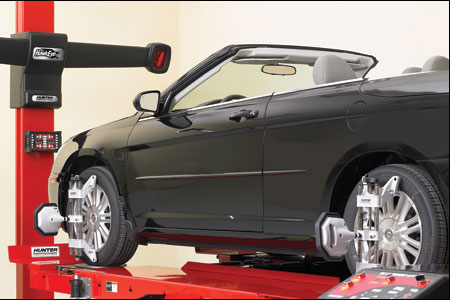
sporing:
The trail is the direction of both the front and rear wheels. The track can be adjusted by making the track rods a little longer or a little shorter on both sides. Space C in the image then becomes larger or smaller. Tie rod head F then moves in or out, changing the wheel position.
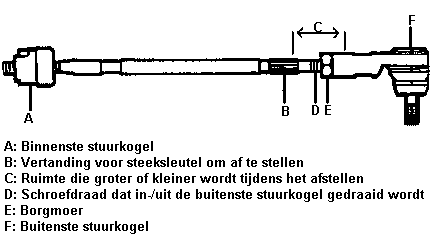
When the wheels are at a standstill slightly towards each other, we call it toe-in, and when they are slightly apart, we call it toe-out. While driving, the wheels come into the straight-ahead position. Toe-in and toe-out are often also referred to as “toe-in” and “toe-out”.
Vehicles with rear-wheel drive are adjusted at the front axle with toe-in. When driving, the wheels are pulled outwards, bringing them into the straight-ahead position. Front wheel drive cars are usually tuned with toe out. When driving, the wheels are pulled inwards, bringing them into the straight-ahead position. The tolerance here is only a few degrees. In the images it is marked 'exaggerated', but in reality it is not easy to see. Special alignment equipment is required to observe this.
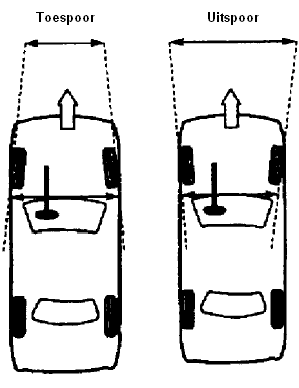
Camber / Camber:
Camber, also called camber (English) or sturz (German), is the inclination of the wheel in relation to the road surface. The camber is measured from a line perpendicular to the horizontal and is indicated in degrees. The camber is performed in two different applications; namely positive camber and negative camber. With positive camber the top of the wheel is further out than the bottom (see image ) and with negative camber the other way around; the top of the wheel is more inward than the bottom.
Negative camber improves road holding in corners and improves stability. That is why lowered sports cars also have a greater negative camber than with a standard wheel suspension. A wheel with negative camber has the property of running inwards and thus pushes the wheel inwards. By aligning the left and right sides, the car will continue to drive straight, but tire wear will increase on the inside of the tires.
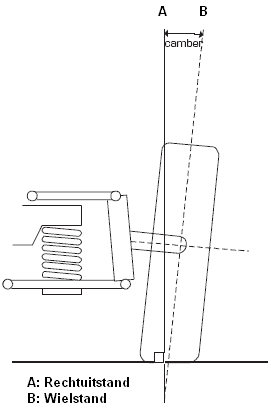
KPI (King Pin Inclination):
The KPI, also called steering axle inclination, is the angle between the line through the steering axle pivots and a perpendicular line on the road surface. The KPI and Caster (next topic) forces the front wheels into the straight-ahead position. This effect arises because the tilt of the pivot point of the wheels raises the car slightly when the wheels are turned. The car's own weight ensures that the wheels are forced back into the straight-ahead position. The impacts of the road surface are also less powerfully transmitted to the steering. When the KPI changes, the camber will also change.

Included angle:
The included angle, also called Included Angle or Gabelwinkel, is not a wheel stand but an addition to the existing concepts of KPI and Camber. The included angle can be determined by adding the values of both angles together.
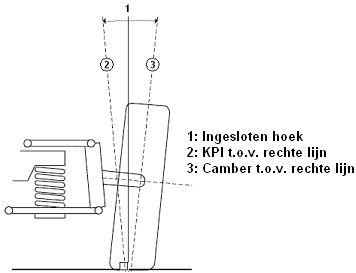
Axle Tilt / Caster:
Axle tilt, also referred to as Caster, Knuckle length slope or Trailing track, is the angle between the centerline through the knuckle pivot B and a perpendicular line to the path through the center of the axle A. Axle tilt is always positive.
The axle tilt gives the car directional stability, because the wheel wants to be in the forward direction when driving straight. You can compare this with the front fork of a bicycle that is always tilted forward. If the wheel were directly under the frame, you would lose control over the steering wheel if you hit a big bump. Even if you turn the steering wheel backwards, you will see that the steering wheel turns again with the wheel forward. This principle is the same for a car; By placing the front wheels under the car at a forward angle, the car will have better road holding and the steering wheel will automatically return to the straight-ahead position while driving.
When designing modern cars, a large axle tilt is often used. This gives the advantage of a very positive driving characteristic. A possible disadvantage of a large axle tilt is that the car will steer more heavily, but with today's power steering that is not a problem.
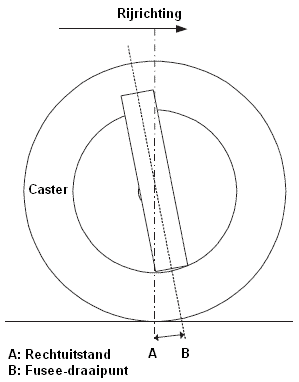
sanding radius:
The scrub radius, also called Scrub Radius or Lenkroll Radius, is the distance between the point where the centerline through the wheel meets the road surface (the wheel point) and the point where the line through the pivot points of the steering touches the road surface (the steering point). The sanding radius determines the extent to which the heights of the front wheels change when turning and is partly responsible for the straight-line stability of the car.
- If the steering pivot point (blue line) is flush with the wheel point (red line), the sanding radius is '0'. This is also called 'a Neutral sanding jet' or 'Centerpoint steering'.
- If the steering pivot point (blue line) is outside the wheel point (red line), the sanding radius is positive.
- If the steering pivot point (blue line) is within the wheel point (red line), the sanding radius is negative.
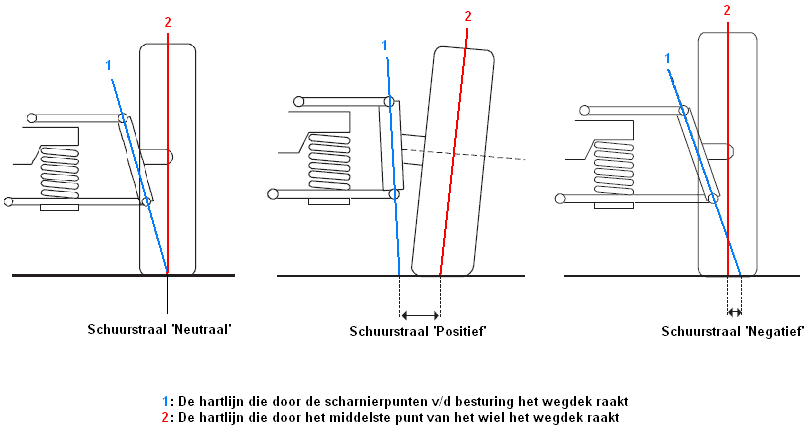
Ackermann principle:
In the images below you can see that the lines from the front wheels come out at the common pivot point. If the wheels were to rotate at the same angle (the wheels are then both rotated at the exact same angle), the lines from the wheels would also run parallel to each other to infinity. They never find the common pivot point M. Therefore, the steering characteristics will be very poor in this situation.
This whole principle isswerve in the bend" named. All modern cars are constructed with this characteristic. On slippery surfaces, e.g. the floor in the parking garage, a squeak of the tires can be heard when turning. That's because of this principle. The inner wheel, which has a greater steering angle than the outer wheel, will experience some form of slip.
When driving straight ahead, all wheels are in the straight ahead position. The extension of the center lines of the steering arms intersect at the center of the rear axle.
When cornering, the inner front wheel will twist further than the outer. This is because the swivel arms are placed at an angle and the wheel on the inside will rotate further. When the car is fully steered, the oblique wheel position will also be clearly visible. This construction will improve the driving characteristics.
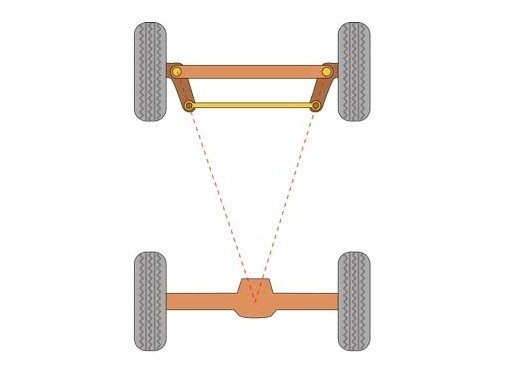
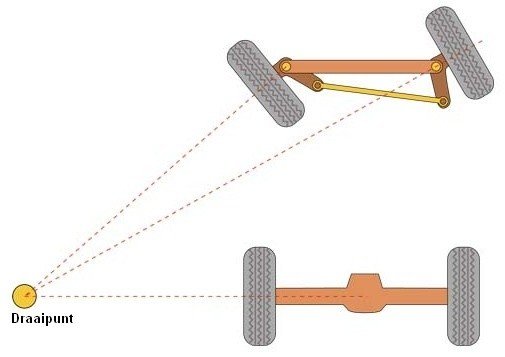
Submitted angle:
The steered angle of a vehicle can be calculated on the basis of a number of data from the car. Below is an image where angle α has been calculated. Calculating angle β is the next step.
On the page swerve in the bend the calculation is explained in great detail in this image.
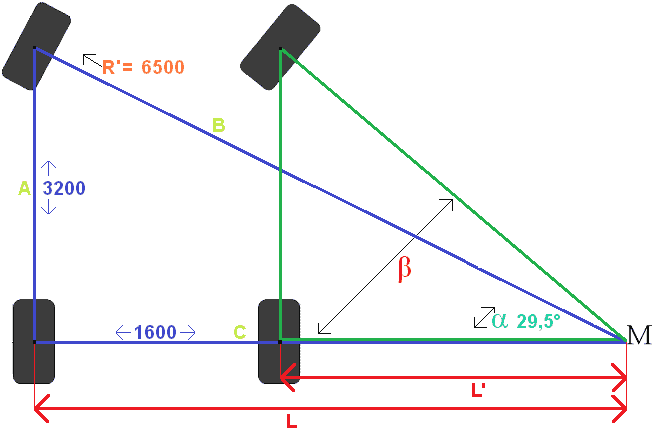
Role Center:
An important point of the wheel suspension is the concept of "roll center". The position of the roll center plays a major role in the handling characteristics. The position of the roll center is determined by the position of the supporting arms. This is a very important concept when designing an undercarriage. Lowering the vehicle also affects the roll center. Click here for more information about the Role Center.
